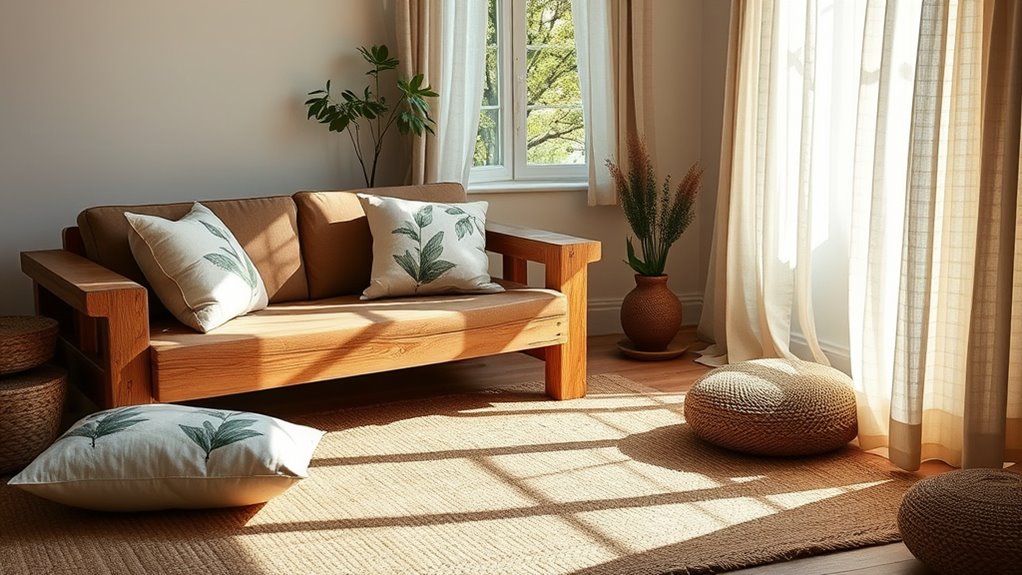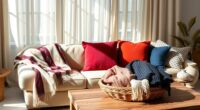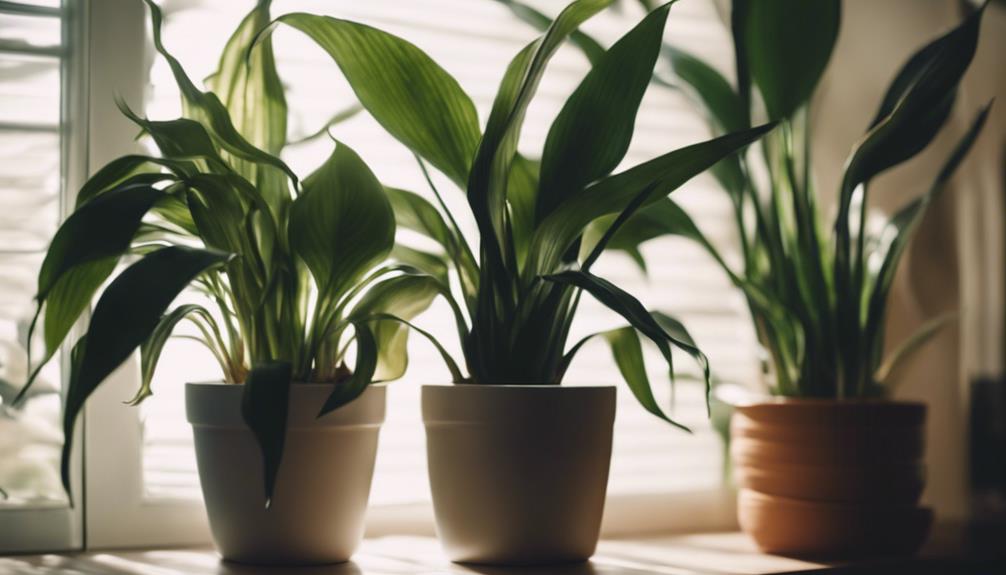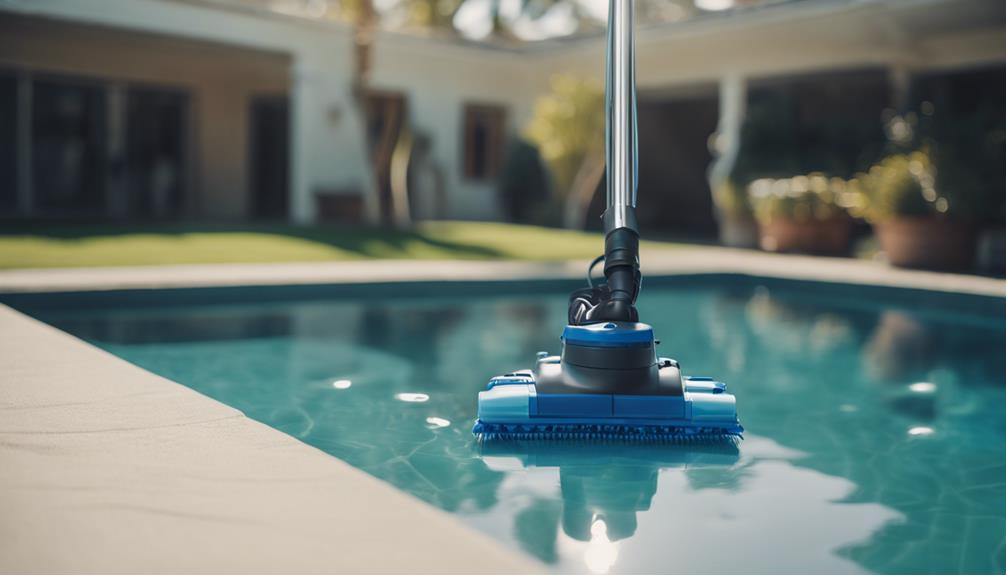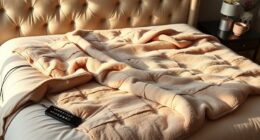Sustainable home textiles are key to a healthier living space and a smaller eco-footprint. By choosing fabrics like organic cotton or recycled materials, you support ethical practices and reduce harmful chemicals in your home. Caring for these textiles properly is essential for longevity. You’ll also discover unique options and brands that align with your values. Continue on to uncover more about the benefits, types, and future of sustainable home textiles to enhance your lifestyle.
Key Takeaways
- Sustainable textiles, such as organic cotton and recycled materials, significantly reduce environmental impact and carbon emissions during production.
- Certifications like GOTS and OEKO-TEX ensure that textiles are produced ethically and free from harmful substances.
- Eco-friendly fabrics enhance health and comfort by minimizing allergens and using skin-friendly natural fibers.
- Proper care and storage techniques, like cold washing and air drying, extend the life of sustainable textiles.
- Supporting eco-conscious brands and local artisans promotes sustainable practices and contributes to a circular economy in textiles.
Understanding Sustainable Textiles
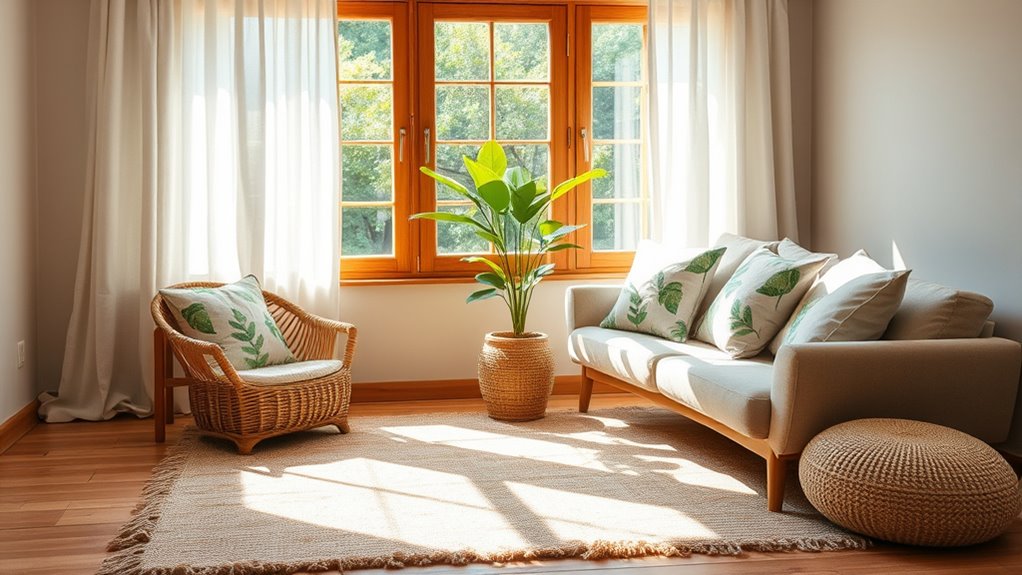
Sustainable textiles play an essential role in reducing our environmental footprint. By opting for fabrics like organic cotton and recycled materials, you minimize water consumption and chemical usage during production. Additionally, understanding zoning regulations for tiny houses can help in the design of sustainable living spaces that utilize eco-friendly textiles. Incorporating best makeup products for women over 50 can also enhance the aesthetic appeal of your home textiles while being mindful of sustainable practices. Moreover, being aware of local regulations regarding tiny houses can further encourage the use of sustainable building materials in your space.
These eco-friendly options not only support the planet but also promote ethical practices. Certifications such as GOTS and OEKO-TEX guarantee that sustainable textiles are produced under safe conditions, free from harmful substances. Choosing these fabrics can considerably lower the carbon emissions associated with textile production, which contributes about 10% of global CO2 emissions. Furthermore, investing in sustainable textiles aligns with the principles of cultural intelligence as it encourages awareness of and respect for diverse cultural practices related to textile production. Plus, sustainable textiles are often more durable, leading to longer-lasting products that help combat the fast fashion cycle. Incorporating best knitting patterns into your home textiles can also enhance their sustainability by encouraging handmade creations.
Benefits of Choosing Eco-Friendly Fabrics
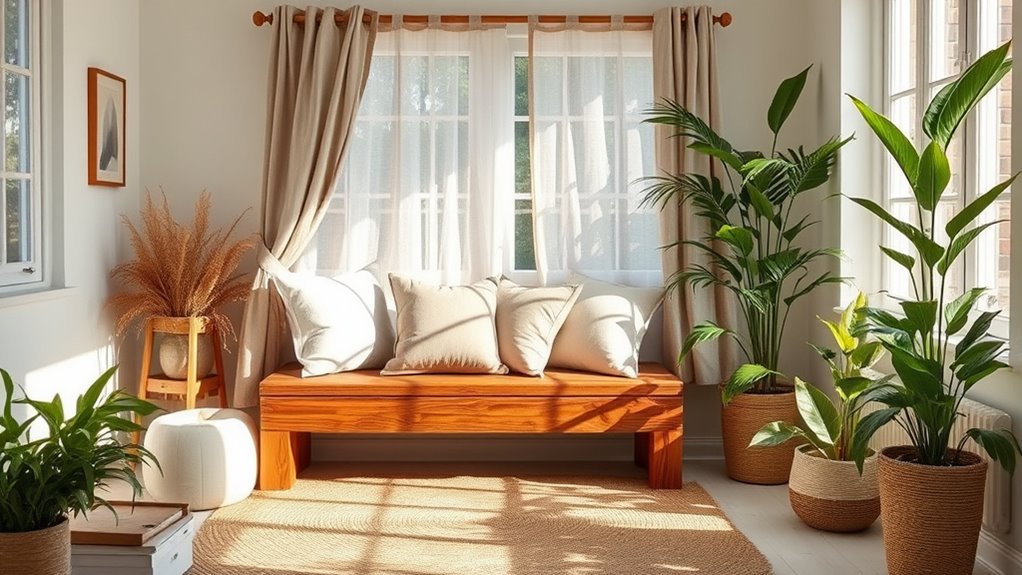
Choosing eco-friendly fabrics isn’t just good for the planet; it also creates a healthier home for you and your family.
By opting for materials like organic cotton or hemp, you cut down on harmful chemicals and allergens while promoting sustainable practices. Additionally, choosing textiles made from natural materials like linen or wool can further enhance the comfort and aesthetic of your home. For example, incorporating nutrient-dense textiles can improve indoor air quality and overall well-being. Furthermore, embracing holistic approaches to health and wellness can lead to a more balanced lifestyle for you and your family. Using natural sweetening alternatives like honey can also contribute to a healthier environment.
Plus, you’ll be supporting fair wages and safer conditions for textile workers around the world.
Additionally, selecting sustainable products aligns with eco-friendly minimalism, reducing your environmental impact while enhancing your overall well-being.
Environmental Impact Reduction
When you opt for eco-friendly fabrics, you’re not just making a choice for your home; you’re actively contributing to a healthier planet. By choosing sustainable practices, like using organic cotton, you reduce water consumption considerably—up to 90% less than conventional methods. Eco-friendly textiles also minimize harmful chemical runoff, protecting local ecosystems. Plus, opting for recycled textiles helps divert waste from landfills, lowering your environmental footprint.
Here’s a quick comparison of eco-friendly options:
| Fabric Type | Water Usage Reduction | Waste Diverted |
|---|---|---|
| Organic Cotton | Up to 90% | – |
| Hemp | 50% | – |
| Recycled Textiles | – | Millions of tons |
| ECONYL Nylon | – | 65,100 tons CO2 saved |
| Bamboo | 30% | – |
Health and Safety Benefits
Opting for eco-friendly fabrics brings more than just environmental advantages; it also enhances your health and safety at home. By choosing organic cotton sheets and other eco-friendly textiles, you reduce exposure to harmful chemicals and pesticides, which can cause skin irritations and allergic reactions, especially for sensitive individuals.
Sustainable fabrics often use natural dyes, improving indoor air quality and overall well-being. Additionally, products made from materials like TENCEL (Lyocell) are biodegradable, helping to lessen landfill waste.
You’ll also find that these textiles offer better breathability and moisture management, enhancing your comfort. Finally, supporting companies that prioritize fair labor practices promotes social responsibility, ensuring safe working conditions for everyone involved in textile production.
Types of Natural Fabrics
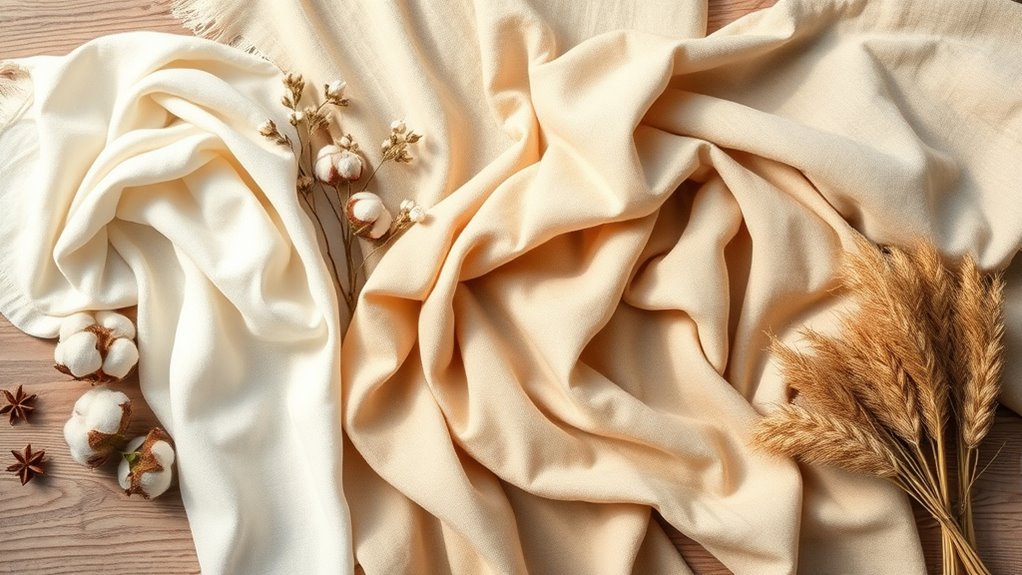
Natural fabrics play an essential role in sustainable home textiles, offering a variety of options that cater to different needs and preferences.
You can choose from plant fibers like organic cotton and linen products, which are both breathable and durable. Organic cotton is soft, moisture-absorbent, and perfect for clothing and home textiles.
On the other hand, linen, made from flax fibers, is highly absorbent and gets softer with each wash, making it ideal for warm climates.
If you’re looking for something even more eco-friendly, consider hemp; it’s incredibly strong and requires minimal water and no pesticides.
Each of these natural fabrics brings unique properties that enhance your sustainable lifestyle while being kind to the environment.
Caring for Sustainable Textiles
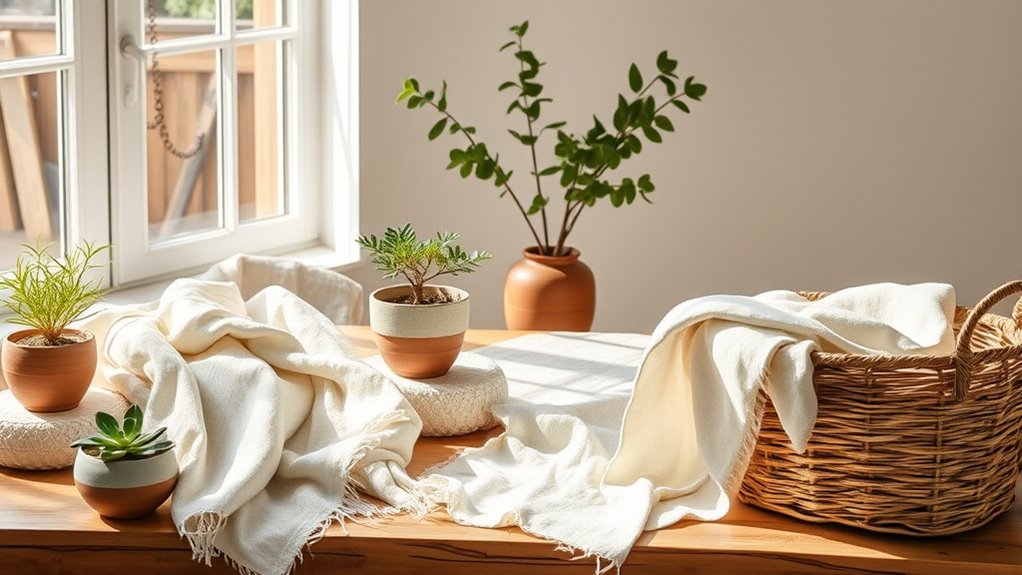
Caring for your sustainable textiles is essential for their longevity and your eco-friendly lifestyle.
You can enhance their durability by using proper washing techniques, effective drying methods, and safe storage practices.
Let’s explore how these steps can keep your fabrics looking great while minimizing environmental impact.
Washing Techniques for Longevity
When it comes to extending the life of your sustainable textiles, washing techniques play an essential role.
Always wash these fabrics in cold water using gentle, eco-friendly detergents, as this preserves their integrity and minimizes energy consumption. Avoid fabric softeners and bleach, which can damage natural fibers and harm the environment.
Regularly clean your washing machine to prevent residue buildup that could negatively impact your textiles’ performance. For specific fibers, like linen and cotton, follow care instructions carefully; linen should be dried flat, while cotton can be tumble-dried on a low setting.
Proper Drying Methods
To maintain the beauty and longevity of your sustainable textiles, it is crucial to choose the right drying methods. Air drying is your best bet, as it prevents damage from heat and keeps the fabric’s integrity intact. For natural fabrics like organic cotton and linen, lay them flat or hang them out of direct sunlight to avoid fading. Bamboo towels should also air dry to retain their softness and absorbency.
| Item Type | Recommended Drying Method |
|---|---|
| Organic Cotton | Air Dry Flat |
| Linen | Air Dry Away from Sun |
| Bamboo Towels | Air Dry |
Always check care labels for any specific instructions to keep your textiles in top shape!
Storing Textiles Safely
Properly storing your sustainable textiles is essential to keep them in great condition for years to come. Choose a cool, dry place away from direct sunlight to prevent fading and deterioration.
Instead of plastic, use breathable cotton or linen bags to avoid moisture buildup and mold growth. Always guarantee your textiles are clean and completely dry before storage to prevent mildew and unpleasant odors.
For delicate fabrics like organic cotton or Tencel, wrap them in acid-free tissue paper to protect against creasing. Additionally, regularly check your stored textiles for signs of pests or damage, and rotate them occasionally to maintain their shape and integrity.
Creating a Capsule Wardrobe With Natural Fabrics
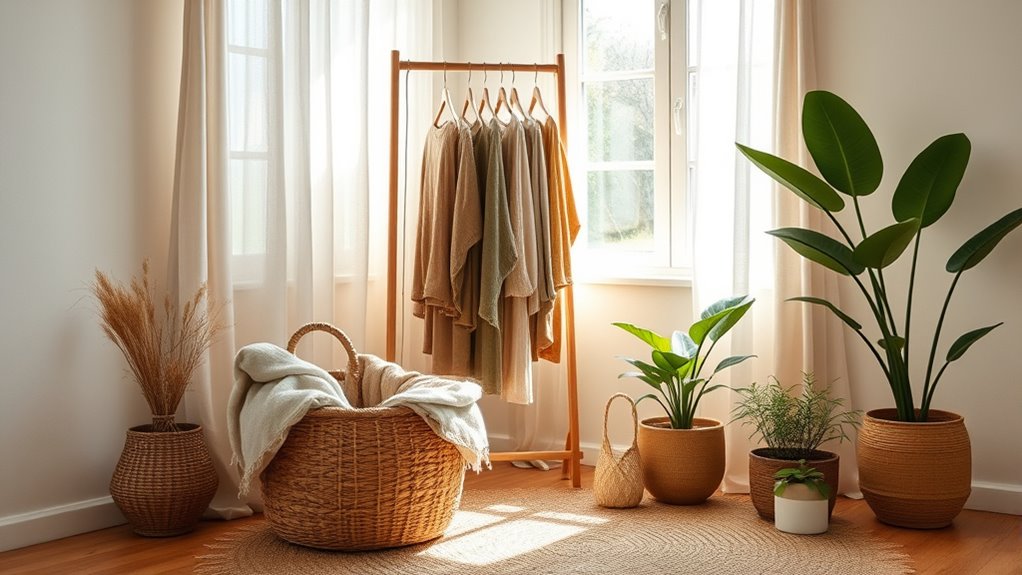
A capsule wardrobe made from natural fabrics is a smart way to embrace sustainability without sacrificing style. By focusing on quality pieces, you can contribute to a more sustainable world while enjoying the benefits of natural materials.
Embrace sustainability with a capsule wardrobe of quality natural fabrics that blend style and eco-consciousness.
Here are some key advantages:
- Durability: Natural fabrics like organic cotton and linen last longer.
- Breathability: They provide comfort in various climates.
- Versatility: A hemp dress or linen shirt can be styled in multiple ways.
- Skin-friendly: Natural fibers reduce irritation compared to synthetics.
- Cost-effective: Less frequent replacements lead to savings over time.
Where to Buy Sustainable Home Textiles
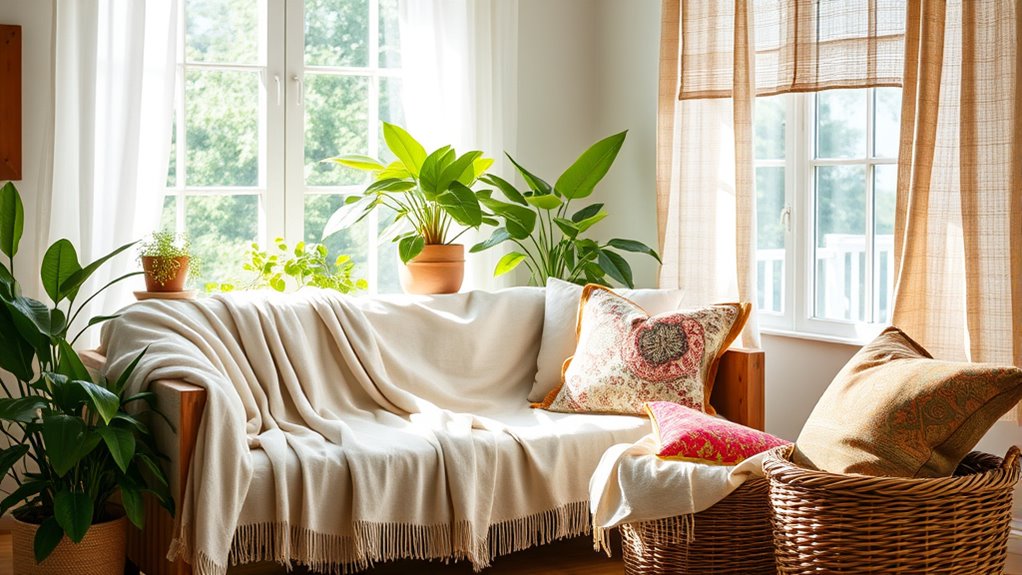
Building a sustainable lifestyle doesn’t stop at your wardrobe; it extends into your home textiles as well.
To find sustainable textiles, explore eco-conscious brands like Takasa, which offers GOTS-certified organic cotton bedding and Fairtrade home goods for ethical purchasing. Online retailers like NovaTomato specialize in on-demand fashion and sustainable home textiles made from recycled materials, helping reduce waste.
Don’t forget to check local stores that focus on organic cotton, linen, and hemp, supporting local economies. Marketplaces like Etsy are also great for finding handmade, sustainable textiles from independent artisans.
Always look for certification labels like OEKO-TEX and Fair Trade to guarantee your purchases are free from harmful chemicals and produced under fair labor conditions.
The Future of Sustainable Fabrics
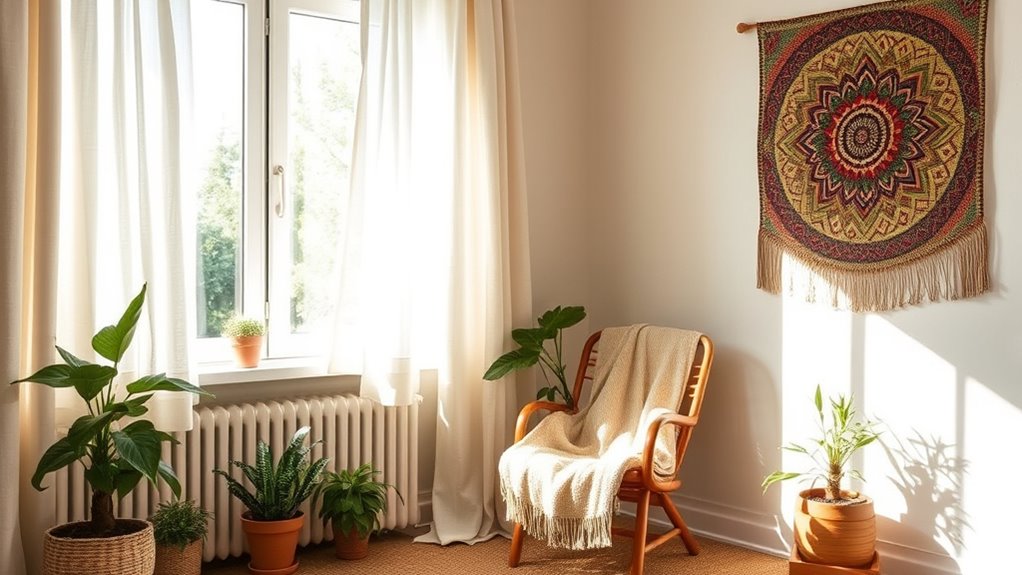
As awareness of environmental issues grows, the future of sustainable fabrics is taking shape through innovative materials and practices.
You’ll find that sustainable textiles are evolving to meet your eco-conscious needs. Expect to see:
- Bio-based materials like biobased Xorel and Lyocell
- ECONYL Regenerated Nylon, made from 100% waste materials
- Certifications such as GOTS and OEKO-TEX for ethical production
- Semi-synthetic fabrics like Tencel, derived from sustainably sourced wood
- Increased consumer demand for eco-friendly materials
With 67% of consumers prioritizing eco-friendly materials, the shift toward recycled textiles and low-impact alternatives isn’t just a trend; it’s the future.
Embracing these innovations will help you make more sustainable choices for your home.
Frequently Asked Questions
What Are the Environmental Impacts of Conventional Textiles?
Conventional textiles have significant environmental impacts. They often involve harmful chemicals during production, which can pollute water sources.
The energy-intensive manufacturing process contributes to greenhouse gas emissions, while synthetic fibers like polyester take centuries to decompose, adding to landfill waste.
Additionally, the fast fashion industry encourages overconsumption, leading to increased textile waste.
How Do I Identify Genuinely Sustainable Brands?
To identify genuinely sustainable brands, start by investigating their transparency.
Look for certifications like GOTS or Fair Trade, which guarantee ethical practices.
Check their materials—organic, recycled, or biodegradable options are key.
Research the brand’s production processes and supply chain, as sustainability goes beyond the product itself.
Finally, read customer reviews and testimonials; real experiences can reveal a brand’s commitment to sustainability.
You’ll feel more confident in your choices!
Can I Find Sustainable Textiles in Thrift Stores?
Absolutely, you can find sustainable textiles in thrift stores!
By exploring these shops, you’re not only giving items a second life but also reducing waste. Look for natural fibers like cotton, linen, or wool, and check for brands known for eco-friendly practices.
Don’t forget to inspect the quality and condition of the textiles. With a little patience and creativity, you’ll discover unique pieces that contribute to a more sustainable lifestyle.
Are Sustainable Textiles More Expensive Than Traditional Options?
You might find that sustainable textiles can be pricier than traditional options, but it’s worth considering the benefits.
Investing in quality means you’re supporting ethical practices, reducing environmental impact, and often enjoying better durability.
While the upfront cost might be higher, think about the long-term savings and positive effects on the planet.
What Certifications Should I Look for in Sustainable Fabrics?
When you’re shopping for sustainable fabrics, look for certifications like Global Organic Textile Standard (GOTS), OEKO-TEX, and Fair Trade.
GOTS secures organic and eco-friendly practices throughout the production process.
OEKO-TEX guarantees that the fabric is free from harmful substances, while Fair Trade focuses on ethical labor practices.
Checking for these certifications not only supports sustainability but also gives you confidence in the quality and ethical sourcing of your textiles.
Conclusion
In a world bursting with options, choosing sustainable home textiles isn’t just a trend—it’s a revolution! You’re not just decorating; you’re making a statement louder than a marching band on parade day. By embracing eco-friendly fabrics, you’re crafting a home that sings with style and conscience. So, plunge into the vibrant world of natural textiles, and let your space reflect your values. Together, we can weave a brighter, greener future—one fabulous fabric at a time!
